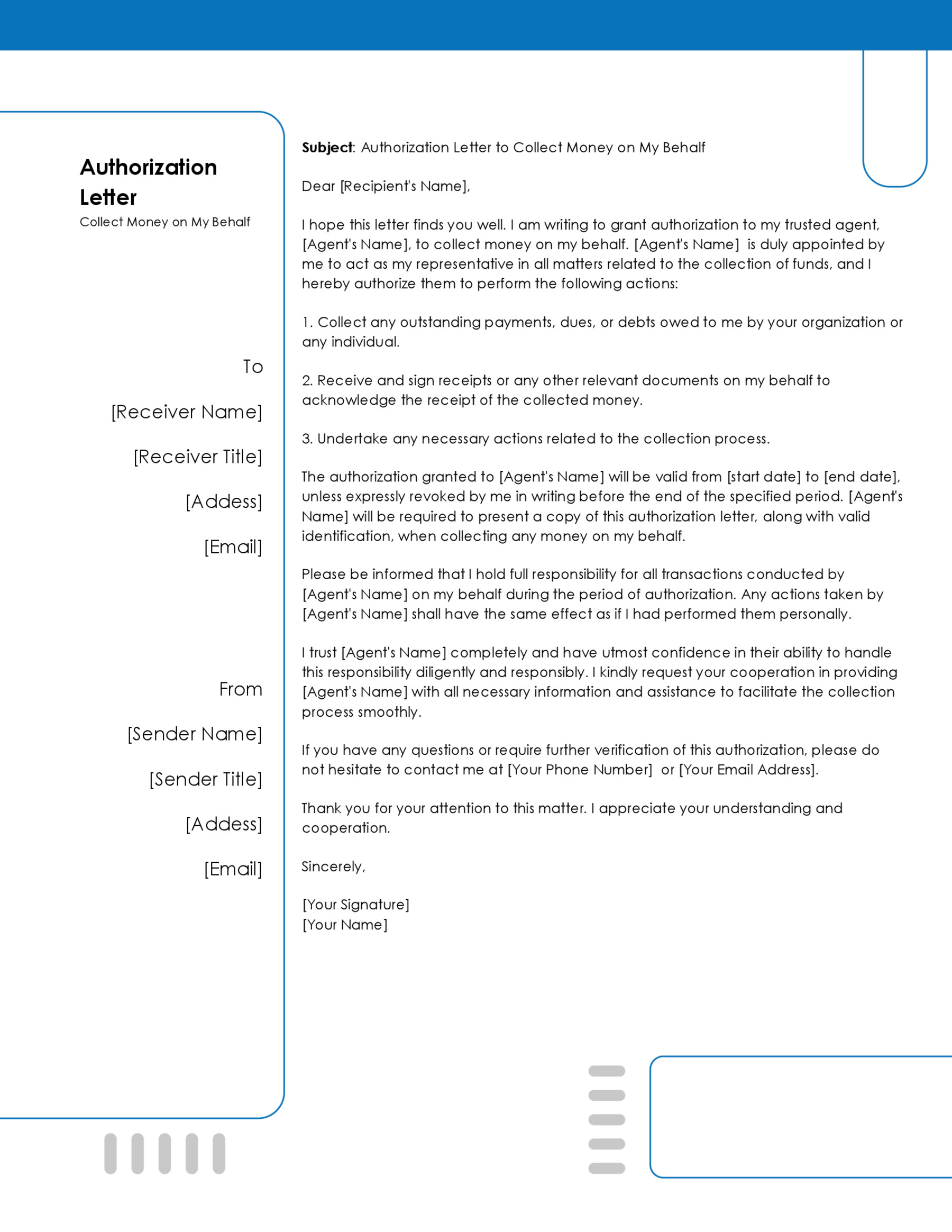In a world where our commitments often outpace the hours in a day and where physical presence is not always possible, you may need to delegate some tasks to other capable parties. This is possible through an authorization letter that seamlessly delegates responsibilities to a trusted individual, permitting them to act on your behalf. It can authorize someone to collect a package in your absence, manage your financial affairs, or represent you legally. In this article, you will learn how it works to delegate your personal and official responsibilities. It will discuss how to craft such a letter to ensure it fulfills its intended purpose. Lastly, it will highlight the different types used to give another party permission to act on your behalf.
It is a written document that grants someone else (the “agent”) the authority to act on your behalf or make decisions on your behalf. This type of letter is commonly used in various situations where you, as the author or executor (the “principal”), are unable to be physically present or personally undertake a specific task or action.
If properly executed, the authorization letter is legally binding and thus demands the agent fulfill the stipulated functions or responsibilities within the limits specified in the letter.
EXAMPLE
Examples of functions you can direct the agent to undertake include signing documents, collecting items, making purchases, accessing confidential information, or completing financial transactions.
By appointing a trusted agent, you can ensure that your transactions or tasks are completed according to your wishes and interests.
Types of Permission Authorization Letters
A letter of authority granting permission proves to be a versatile tool with vast implications. It is useful whether you are seeking to streamline your interactions with institutions, offer a lifeline during emergencies, or simply unburden yourself from the commitments of everyday life.
The following are examples of common letters that can be used in a variety of situations:
Authorization letter for the processing of documents
It is commonly used when you are unable to personally process documents due to various reasons such as travel, illness, or time constraints. These could include legal documents, financial paperwork, or administrative forms. You can authorize the agent to make submissions, file applications, or sign documents through this letter.
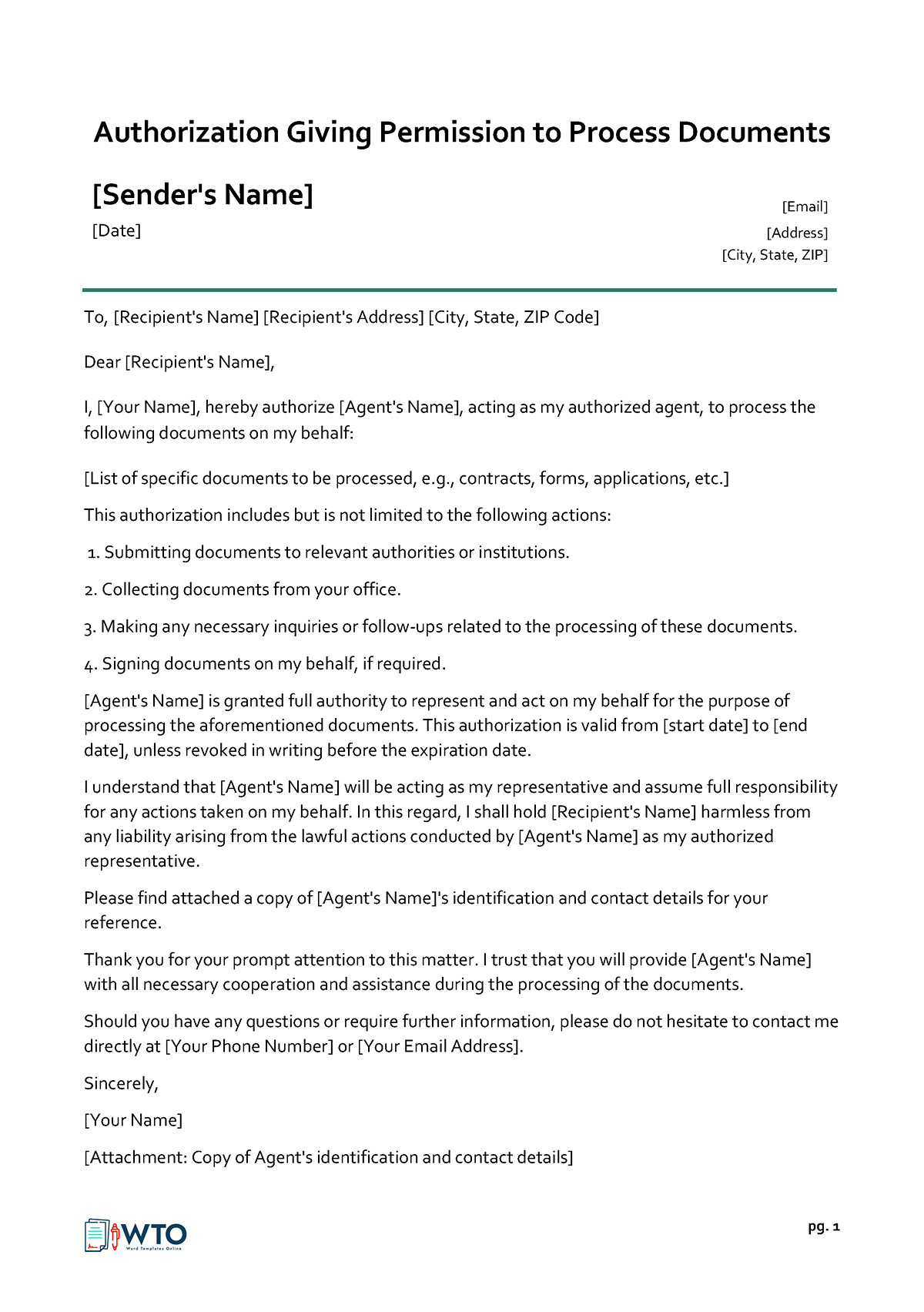
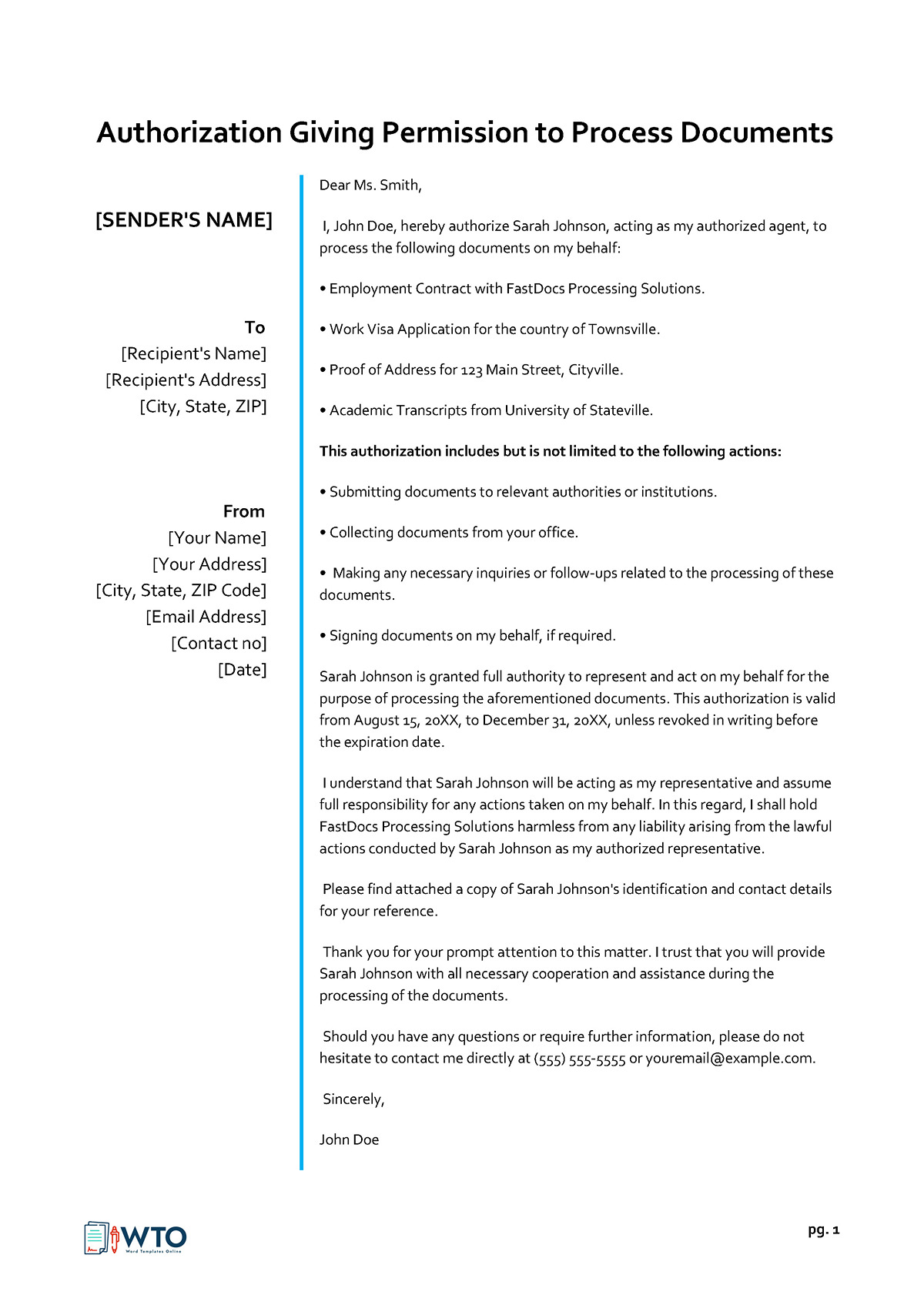
Authorization letter for medical treatment
It is crucial when you need someone else, such as a family member or trusted friend, to make medical decisions on your behalf. It is often used when you cannot provide consent for treatment or medical procedures due to illness, surgery, or any other incapacitating condition. When drafting this letter, it is important to include specific medical details, such as the types of treatments or procedures the authorized person can consent to and any limitations you wish to impose.
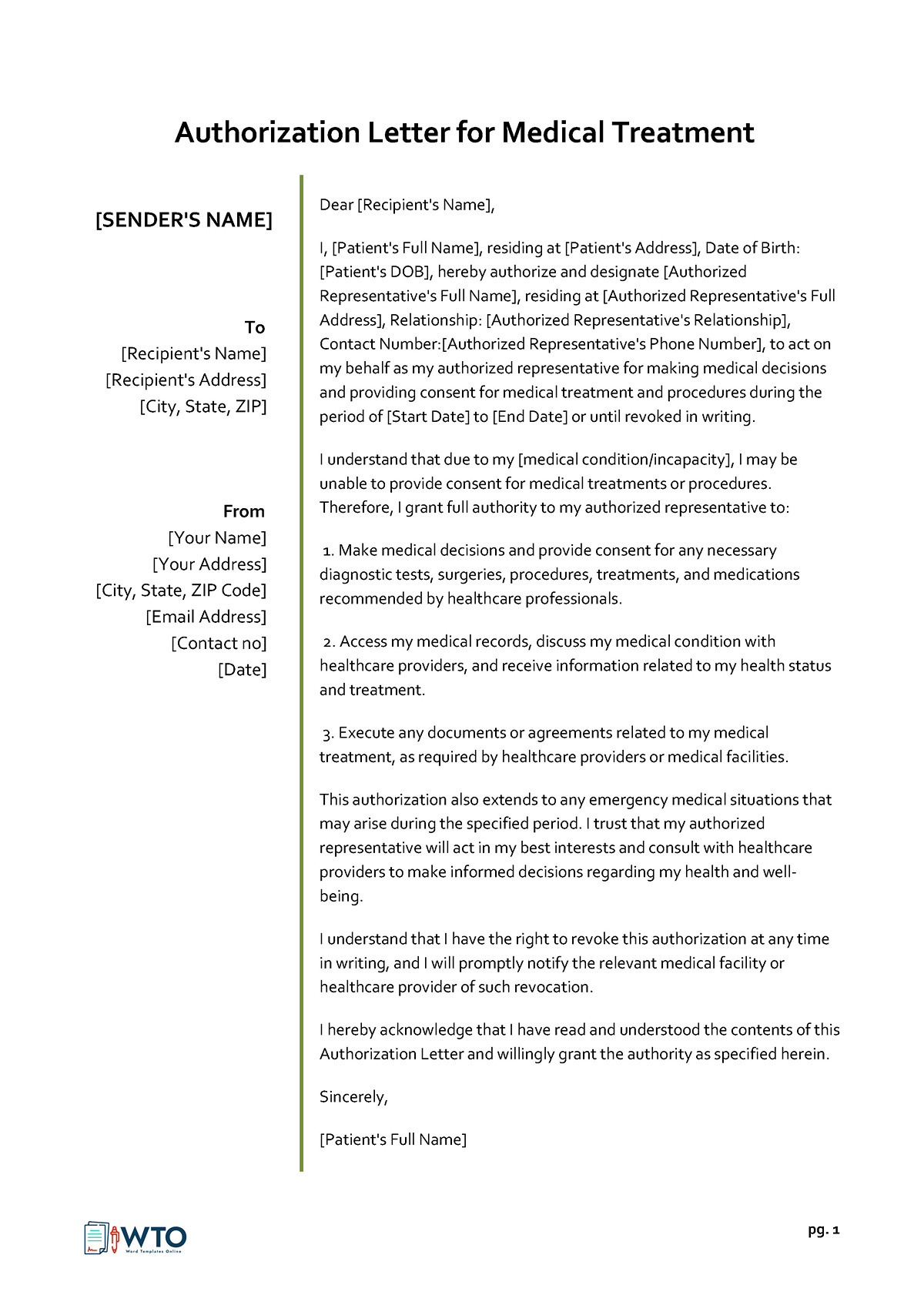
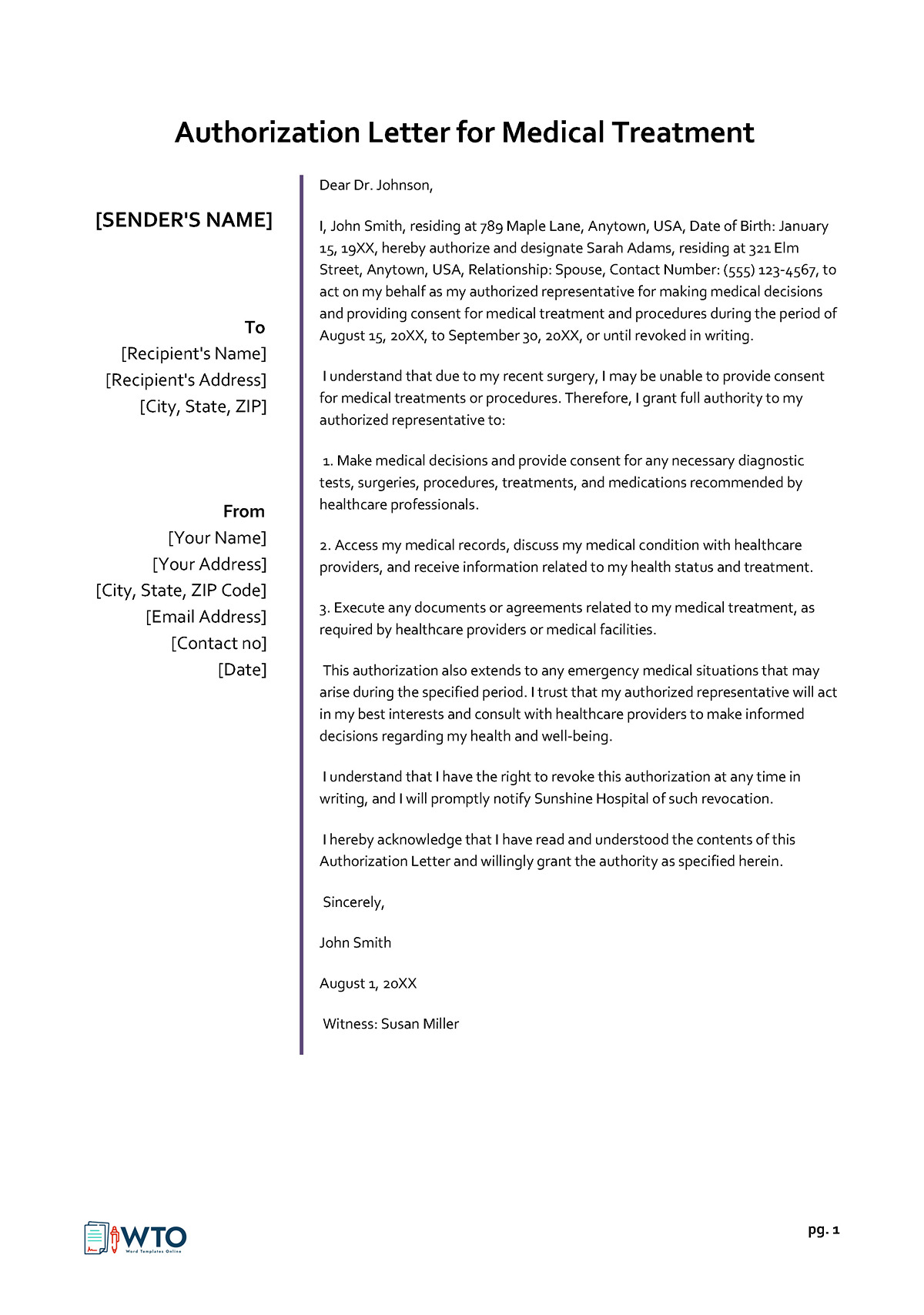
Authorization letter to release information
It is used when you want to grant an agent permission to access and obtain specific confidential or sensitive information about you or your affairs. This could be for purposes such as legal matters, financial transactions, medical decisions, or personal inquiries. This letter should specify the limits of its use to protect the privacy of your data.
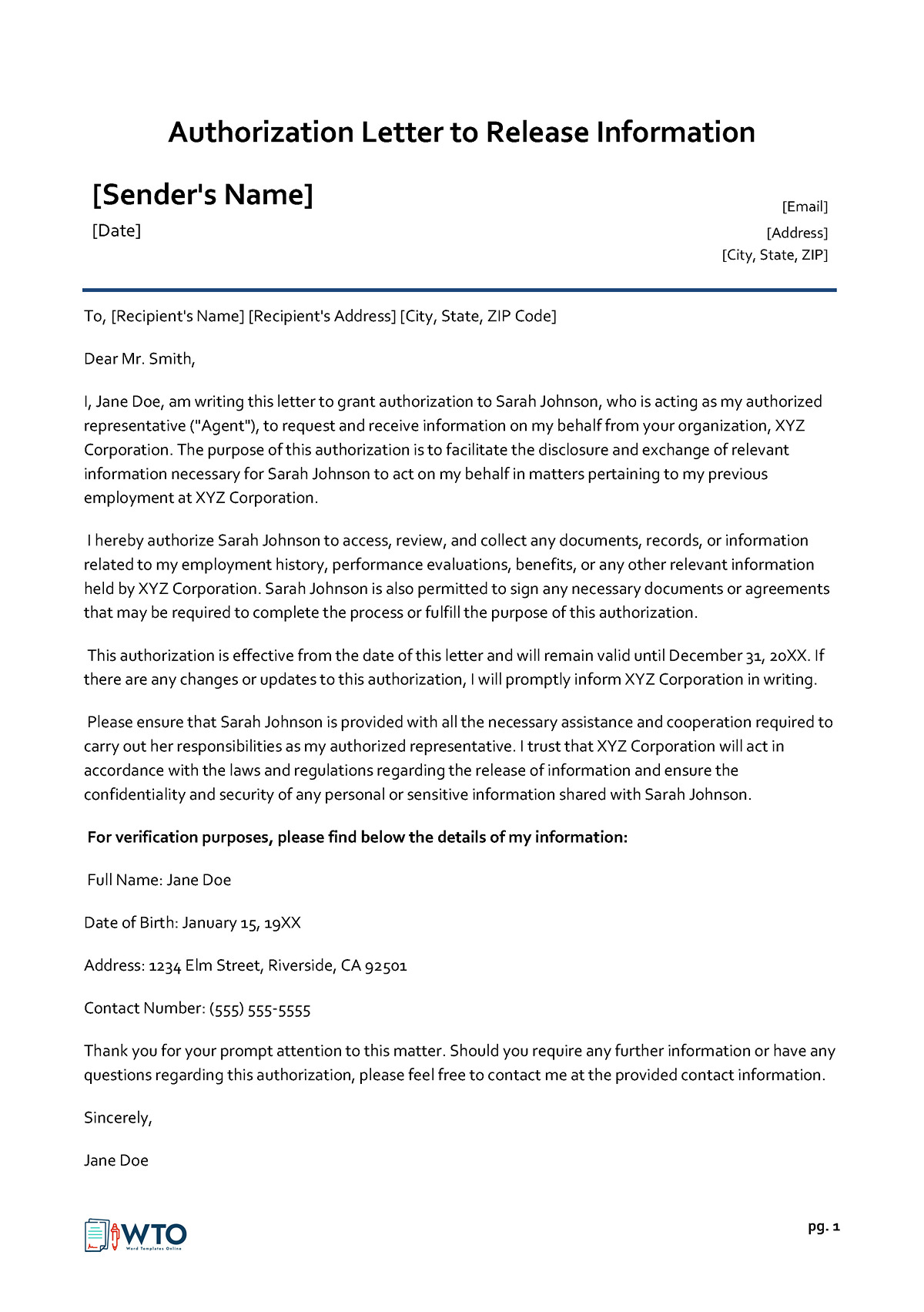
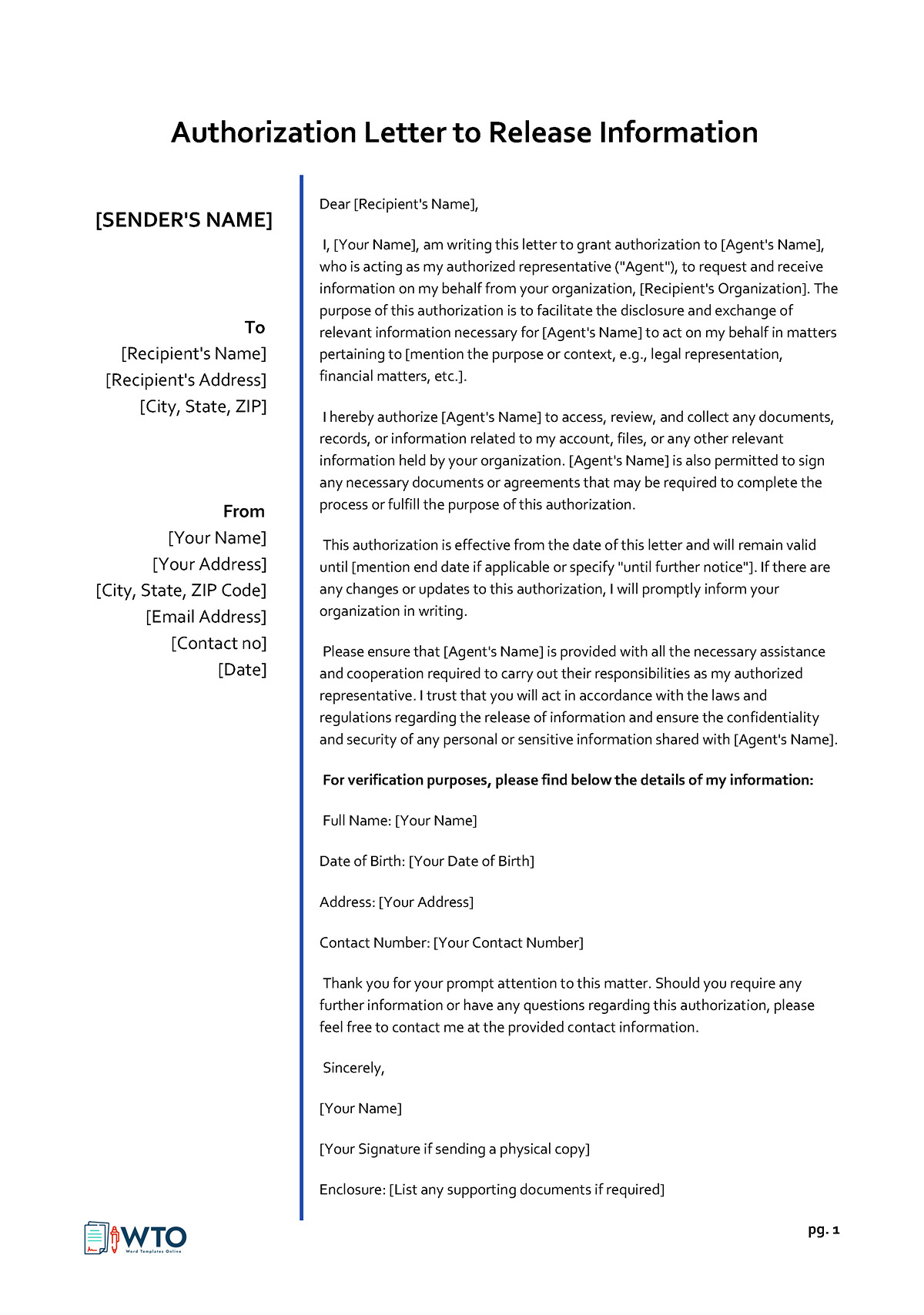
Step-by-Step Guide on How to Format the Letter
Formatting it and granting permission requires thorough attention to detail to ensure the letter is clear, concise, and legally valid. Each component within the letter’s structure serves a specific purpose, i.e., to outline the authorization clearly and avoid any potential misunderstandings.
Follow these step-by-step instructions to craft it effectively:
Step 1: Add your information
Begin the letter by adding your name, address, and contact information at the top of the page. This header helps the recipient identify who is granting the authorization. Then, leave a blank line and proceed to indicate the date of writing. Ensure the content of the header is aligned to the left-hand side of the page. The header provides context and helps establish your identity as the principal.
EXAMPLE
Chris Jones
4th Street
Anycity, NY 0393
(555) 3203-2229
christjon@email.com
August 10, 20xx
Step 2: Address the recipient
Next, address the recipient of the letter. This could be an individual, an organization, or a specific department. Use their full name, a title such as Mr./Mrs./Ms. or Dr (if relevant), company name, and complete address. Then, provide a formal salutation – “Dear [Recipient’s Name]”. Properly addressing the recipient ensures that the letter reaches the intended party and demonstrates professionalism.
EXAMPLE
Michael Richards
Branch Manager
Hideaway Bank
53rd Melrose Avenue
Anycity, NY 0389
Dear Mr. Richards,
Step 3: State the authorization
In the opening paragraph, clearly state that you are granting authorization for the agent to act on your behalf. A proper authorization statement will include your name, the agent’s full name, and a clear articulation of the authorization’s purpose.
Use a formal tone and specify that the purpose of the letter is to provide permission for certain actions or decisions. This sets the tone for the remainder of the letter and establishes the primary reason for writing.
EXAMPLE
I am writing this letter to formally grant authorization to Anette Higgins to act on my behalf in matters related to financial transactions.
Step 4: Specify the purpose and tasks
In this step, detail the specific tasks or actions the authorized individual is permitted to undertake on your behalf. Be precise and specific, outlining each responsibility clearly. For example, if you authorize someone to collect a package, provide the relevant tracking number and any necessary identification documents. Specificity avoids confusion and ensures that the recipient understands the agent’s role.
EXAMPLE
The purpose of this letter is to allow Anette Higgins to access my account information, oversee transactions, retrieve bank statements, and sign documents. This authorization is applicable to the following accounts;
Account Name: Chris Jones
Account Number: 8792 0234 1420 2002
Account Type: Checking
Any decisions or actions taken by Anette Higgins per this authorization letter will have the same legal standing as if I had personally taken them.
Step 5: Mention the duration
Indicate the duration for which the authorization is valid. State the start and end dates of the authorization period. If the authorization is single-use or open-ended until further notice, ensure to clarify. This step is particularly important when the authorization is time-sensitive, as it prevents the recipient from assuming ongoing authority beyond the intended timeframe.
EXAMPLE
This authorization is effective from August 10, 20xx, to September 10, 20xx, during which Anette Higgins will have the authority to make decisions and perform tasks as required within the scope of the stated purpose.
Step 6: Include any restrictions
Next, if there are any limitations, restrictions, or conditions to the authorization, outline them clearly in this section. For instance, if the authorized individual is only allowed to perform certain tasks but not others, specify these boundaries. Restrictions prevent potential misuse of authority and provide additional clarity.
EXAMPLE
The representative is not permitted to approve transactions or transfers valued at more than $1000. Expenses shall be limited to transactions for utilities and travel; recreational and investment activities are not permitted.
note
It is important to note that while it grants authority to the agent, it does not outright absolve you of ultimate responsibility. You remain accountable for the actions undertaken on your behalf by the authorized individual. Therefore, it is crucial to choose who you authorize carefully and clearly outline their authority limits in the letter.
Step 7: Closing and signature
In the closing paragraph, express your confidence in the agent’s ability to carry out the authorized tasks responsibly. Use a polite and appreciative tone to thank the recipient for their cooperation. Finally, sign off the letter with a complimentary close, your signature, and your full legal name. If necessary, you can also include your contact information for further correspondence.
EXAMPLE
I trust Anette Higgins completely and believe that they will fulfill the responsibilities outlined in this authorization letter diligently and in alignment with my interests.
Please provide them with any necessary information or assistance to facilitate their tasks during the authorized period. If there are any significant developments or matters that require my attention, kindly communicate them to me through the contact details provided in the header of this letter.
Thank you for your understanding and cooperation in this matter.
Sincerely,
[Your Signature]
Chris Jones
Template
[Your Full Name]
[Your Address]
[City, State, Zip Code]
[Phone Number]
[Email Address]
[Date]
[Recipient’s Full Name or Institution’s Name]
[Their Address (if applicable)]
[City, State, Zip Code]
Subject: Letter of Authorization
Dear [Recipient’s Name or Institution’s Name],
I, [Your Full Name], hereby authorize [Name of Authorized Person], holding identification number [ID Number/Passport Number], to act on my behalf in regards to [specifically describe the matter, e.g., managing my bank account, processing my documents, or making decisions about my medical treatment], starting from [Start Date] until [End Date, if applicable].
[In the next paragraph, provide detailed information about the authorization. This could include specific tasks the authorized person can perform, any limitations to their authority, or any relevant account numbers or document titles.]
Please find attached a copy of [Name of Authorized Person]’s identification for your records. I trust that all actions taken by [Name of Authorized Person] will be treated with the same validity as my own.
I appreciate your cooperation and attention to this matter. Should you require any further information or clarification, please do not hesitate to contact me directly at [Your Phone Number] or via email at [Your Email Address].
Thank you for your assistance.
Sincerely,
[Your Signature (if sending a hard copy)]
[Your Printed Name]
Attachments:
Copy of [Name of Authorized Person]’s Identification
[Any other relevant documents]
Sample Authorization Letter
Subject: Authorization to Handle Financial Transactions
Dear [Manager’s Name],
I, John A. Doe, am writing this letter to formally authorize Ms. Jane B. Smith, my sister, to handle all financial transactions related to my account at Hometown Bank (Account Number: 123456789) on my behalf. I will be abroad from March 15, 20XX, to June 15, 20XX, and during this period, I will not be available to manage my financial matters directly.
Ms. Smith has my full consent to conduct transactions, including but not limited to, withdrawing and depositing money, making payments, and transferring funds as necessary. This authorization is valid for the duration of my absence, as stated above.
Please find attached a copy of Ms. Smith’s identification (Passport Number: AB1234567) for your records and verification purposes. I trust that all transactions she conducts will be regarded with the same authority as my own.
I kindly request that Hometown Bank cooperates with Ms. Smith in executing this authorization and provides her with the necessary access and assistance to manage the financial transactions as mentioned. Should you require any further information or clarification, please do not hesitate to contact me via email at john.doe@email.com or by phone at (555) 123-4567.
Thank you for your attention to this matter and for your continued support.
Sincerely,
[Signature]
John A. Doe
Attachments:
- Copy of Jane B. Smith’s Identification
Analysis
This authorization letter clearly delegates the management of financial transactions to a designated individual during the author’s absence, showcasing effective communication and necessary documentation. It precisely outlines the authorizer’s intent, the authorized individual’s identity, relevant account details, and the specific timeframe the authorization covers, ensuring clarity and avoiding ambiguity.
By detailing permissible transactions and attaching identification for verification, the letter adheres to banking protocols, emphasizing security and the seriousness of the authorization. The inclusion of broad transaction permissions grants the authorized party flexibility in account management without the need for additional authorizations.
The letter courteously requests the bank’s cooperation, providing contact information for any required clarifications, balancing the need for security with a straightforward appeal for support from the financial institution. This ensures that the account will be efficiently managed in the author’s absence.
Overall, the letter is a concise and comprehensive template for authorizing financial transaction management by a trusted individual, ensuring the account holder’s peace of mind while away.
Key Takeaways
- A letter of authority allows you to delegate responsibilities to a trusted individual, permitting them to act on your behalf in your absence.
- The proper format of such a letter includes adding a header with your name, address, and date; addressing the recipient; stating the authorization explicitly; specifying tasks, duration, and restrictions; and closing with your signature.
- Such a letter can be used to delegate trivial tasks like collecting packages to vital functions such as managing finances or representing you legally.
- It is legally binding, and the agent must fulfill their responsibilities within the specified limits.
- While appointing an agent, selecting a trustworthy individual or entity is important to ensure your wishes and interests are protected throughout the period when the representative will be acting on your behalf.

